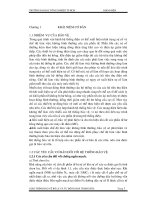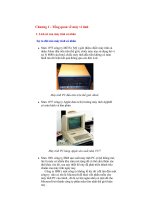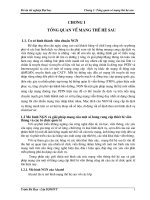geology (1)
Bạn đang xem bản rút gọn của tài liệu. Xem và tải ngay bản đầy đủ của tài liệu tại đây (5.36 MB, 86 trang )
Geology and Nonrenewable Minerals
Chapter 14
Core Case Study: Environmental Effects
of Gold Mining
Gold producers
•
•
•
•
South Africa
Australia
United States
Canada
Cyanide heap leaching
• Extremely toxic to birds and mammals
• 2000: Collapse of a dam retaining a cyanide
leach pond
• Impact on organisms and the environment
Gold Mine with Cyanide Leach Piles and
Ponds in South Dakota, U.S.
14-1 What Are the Earth’s Major
Geological Processes and Hazards?
Concept 14-1A Gigantic plates in the earth’s crust
move very slowly atop the planet’s mantle, and wind
and water move the matter from place to place
across the earth’s surface.
Concept 14-1B Natural geological hazards such as
earthquakes, tsunamis, volcanoes, and landslides
can cause considerable damage.
The Earth Is a Dynamic Planet
What is geology?
Three major concentric zones of the earth
• Core
• Mantle
• Including the asthenosphere
• Crust
• Continental crust
• Oceanic crust: 71% of crust
Major Features of the Earth’s Crust and
Upper Mantle
Volcanoes
Abyssal hills
Abyssal Oceanic
ridge
floor
Ab
ys
sa
lp
lai
n
Oceanic crust
(lithosphere)
Abyssal
floor Trench
Mantle
(lithosphere)
Folded
mountain belt
Craton
Abyssal
plain
Continental
shelf
Continental
slope
Continental
rise
Continental crust (lithosphere)
Mantle (lithosphere)
Mantle
(asthenosphere)
Fig. 14-2, p. 346
The Earth Beneath Your Feet Is
Moving (1)
Convection cells, or currents
Tectonic Plates
Lithosphere
The Earth Beneath Your Feet Is
Moving (2)
Three types of boundaries between plates
• Divergent plates
• Magma
• Oceanic ridge
• Convergent plates
• Subduction
• Subduction zone
• Trench
• Transform fault; e.g., San Andreas fault
The Earth’s Crust Is Made Up of a Mosaic
of Huge Rigid Plates: Tectonic Plates
Spreading center
Ocean
trench
Pl
e
vem
o
m
a te
nt
Plate m
o
vemen
t
Subduction
Oceanic crust Oceanic crust
zone
Continental
crust
Material cools Cold dense
as it reaches material falls
the outer back through
mantle
mantle
Continental
crust
Mantle Hot material
rising
convection
through the
cell
mantle
Two plates move
towards each other.
One is subducted
back into the mantle
on a falling convection
current.
Mantle
Hot outer
core
Inner
core
Fig. 14-3, p. 346
The Earth’s Major Tectonic Plates
EURASIAN PLATE
JUAN DE
FUCA PLATE
PACIFIC
PLATE
NORTH
AMERICAN
PLATE
CARIBBEAN
PLATE
ANATOLIAN
PLATE
CHINA
SUBPLATE
AFRICAN
PLATE
COCOS
PLATE
NAZCA
PLATE
SCOTIA
PLATE
Divergent plate boundaries
SOUTH
AMERICAN
PLATE
PHILIPPINE
PLATE
ARABIAN
PLATE INDIA
PLATE
SOMALIAN
SUBPLATE
PACIFIC
PLATE
AUSTRALIAN
PLATE
ANTARCTIC PLATE
Convergent plate
boundaries
Transform faults
Fig. 14-4, p. 347
The San Andreas Fault as It Crosses Part
of the Carrizo Plain in California, U.S.
Some Parts of the Earth’s Surface Build
Up and Some Wear Down
Internal geologic processes
• Generally build up the earth’s surface
External geologic processes
• Weathering
• Physical, Chemical, and Biological
• Erosion
• Wind
• Flowing water
• Human activities
• Glaciers
Weathering: Biological, Chemical, and
Physical Processes
Parent material
(rock)
Biological
weathering
(tree roots
and lichens)
Chemical
weathering
(water, acids,
and gases)
Physical
weathering
(wind, rain,
thermal expansion
and contraction,
water freezing)
Particles of parent material
Fig. 14-6, p. 348
Parent material
(rock)
Biological
weathering
(tree roots
and lichens)
Chemical
weathering
(water, acids,
and gases)
Physical
weathering
(wind, rain,
thermal expansion
and contraction,
water freezing)
Particles of parent material
Stepped Art
Fig. 14-6, p. 348
Volcanoes Release Molten Rock from
the Earth’s Interior
Volcano
• Fissure
• Magma
• Lava
1980: Eruption of Mount St. Helens
1991: Eruption of Mount Pinatubo
Benefits of volcanic activity
Creation of a Volcano
Extinct
volcanoes
Eruption cloud
Ash
Acid rain
Ash flow
Lava flow
Mud flow
Central vent
Landslide
Magma conduit
Magma reservoir
Solid phere
s
litho
lten
o
m
ally
Parti osphere
n
asthe
in g
l
l
e
Upw ma
m ag
Fig. 14-7, p. 349
Earthquakes Are Geological Rock-andRoll Events (1)
Earthquake
•
•
•
•
•
Seismic waves
Focus
Epicenter
Magnitude
Amplitude
Earthquakes Are Geological Rock-andRoll Events (2)
Richter scale
•
•
•
•
•
•
Insignificant: <4.0
Minor: 4.0–4.9
Damaging: 5.0–5.9
Destructive: 6.0–6.9
Major: 7.0–7.9
Great: >8.0
Earthquakes Are Geological Rock-andRoll Events (3)
Foreshocks and aftershocks
Primary effects of earthquakes
Major Features and Effects of an
Earthquake









